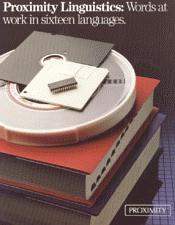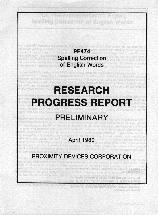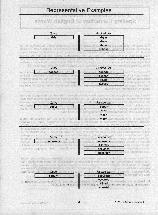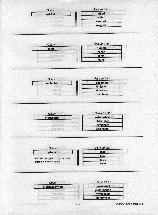
The Proximity Linguistic System provided multi-lingual,
portable, high quality, basic linguistic functionality
| OEM Software Components | 1980-... |

Description: Spelling error detection and correction, hyphenation, thesaurus, dictionary, and basic grammar functions were provided in 16 languages by the PLS (Proximity Linguistic System) software components. Proximity merged with Franklin Electronic Publishers in 1988 and now operates as a subsidiary of Franklin. Its software components have been used by roughly 200 manufacturers and software publishers world-wide, and tens of millions of individual products.
Background: Beginning with simple spelling-error checking in the 1980, Proximity developed a line of "software components" for linguistic functions across many languages. These were first licensed to manufacturers of word processors, and later to software publishers as the PC emergence diminished the role of these specialized machines. From the start they were implemented in C, and in the absence of an ANSI standard, our focus on portability was an important part of the technology's success. We viewed ourselves as a "standard product company." This distinguished our efforts from those of many software firms that accepted contract development and product customization requests. By contrast we focused on a single high quality release that was licensed to all customers.

There were four main dimensions to the product's quality: 1) the linguistic database itself; 2) the degree of compression and resulting speed of retrieval/search; 3) the effectiveness of the linguistic function delivered; 4) the software's ease-of-use from the standpoint of the implementing programmer. The first of these was approached initially by constructing databases ourselves. Soon however the breadth and variety of the market was evident and we instead cultivated relationships with the world's leading dictionary publishers starting with Merriem-Webster in the United States. The company's technology provided key advantages for items 2 and 3. We established the state-of-the-art with respect to compression, and in most cases effectiveness. Proximity introduced the idea of spelling correction that goes beyond simple typographical errors and allows phonetic errors as well. A feature of PLS was that a user could add words to the system while preserving the ability to perform spelling correction. Our software engineering staff focused on 4 and over the years quality was addressed by evolving a "Proximity way" of coding, maintaining, releasing, and testing.

Beyond word processing the PLS system was used in OCR devices to enhance accuracy, electronic typewriters to detect spelling errors as keys are pressed, and in database retrieval systems to improve stem analysis and thesaurus functions. The PLS releases intended for typewriters formed the basis for the the Franklin spelling correctors ( The Franklin Spellers ).



